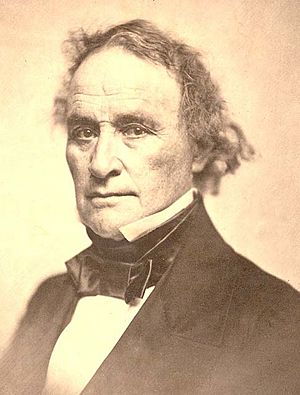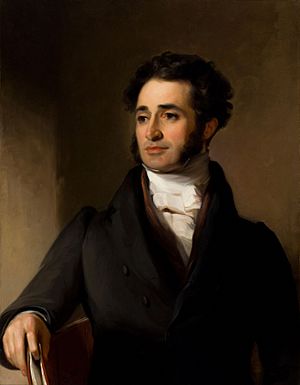Jared Sparks facts for kids
Quick facts for kids
Jared Sparks
|
|
|---|---|
 |
|
| 17th President of Harvard College (now Harvard University) | |
| In office 1849–1853 |
|
| Preceded by | Edward Everett |
| Succeeded by | James Walker |
| 1st McLean Professor of Ancient and Modern History Harvard College |
|
| In office 1838–1849 |
|
| 16th Chaplain of the United States House of Representatives | |
| In office December 10, 1821 – December 5, 1822 |
|
| Preceded by | John Nicholson Campbell |
| Succeeded by | John Brackenridge, D.D. |
| Personal details | |
| Born | May 10, 1789 Willington, Connecticut |
| Died | March 14, 1866 (aged 76) Cambridge, Massachusetts |
| Spouses | 1832, Frances Ann Allen, d. 1835. 1839, Mary Crowninshield Silsbee. |
| Alma mater | Phillips Exeter Academy, Harvard College, (now Harvard University) |
| Profession | Historian, educator, and minister |
| Signature | |
Jared Sparks (born May 10, 1789 – died March 14, 1866) was an important American historian, teacher, and Unitarian minister. He was the President of Harvard College from 1849 to 1853.
Contents
Jared Sparks' Early Life and Education
Jared Sparks was born in Willington, Connecticut. As a young man, he went to local schools and worked as a carpenter. Later, he became a schoolteacher.
From 1809 to 1811, he studied at the Phillips Exeter Academy. There, he met John G. Palfrey, who became a lifelong friend. Sparks then went to Harvard College, which is now Harvard University. He earned his first degree in 1815 and a master's degree in 1818.
While at Harvard, he was part of a student group called the Hasty Pudding. He also worked as a tutor for children in Havre de Grace, Maryland, in 1812. A few years later, he taught at a private school in Lancaster, Massachusetts. Sparks also studied theology (the study of religion) and taught math and science at Harvard College. From 1817 to 1818, he helped edit the North American Review magazine.
Becoming a Minister and Editor

Jared Sparks became the first pastor of the "First Independent Church of Baltimore." He served there from 1819 to 1823. This church later became known as the First Unitarian Church of Baltimore.
At his ordination, Dr. William Ellery Channing gave a famous speech. This speech, known as "The Baltimore Sermon," explained the ideas of Unitarian Christianity. These ideas led to the creation of the American Unitarian Association in 1825.
During this time, Sparks started a monthly magazine called Unitarian Miscellany and Christian Monitor. He also served as the chaplain for the United States House of Representatives from 1821 to 1823. He wrote for other newspapers and magazines too.
In 1823, Sparks left the ministry because of his health. He moved to Boston and bought the North American Review magazine. He edited it from 1824 to 1830 and wrote about 50 articles for it. In 1830, he also started the American Almanac and Repository of Useful Knowledge. This yearly book was very popular for a long time.
In 1825, Sparks became a member of the American Academy of Arts and Sciences. In 1827, he joined the American Antiquarian Society. He later worked as the secretary for foreign correspondence for this society for 20 years.
Sparks' Work as a Historian
Jared Sparks traveled to London and Paris in 1828–1829 to do research. His most important work was The Writings of George Washington, which came out in 12 volumes between 1834 and 1837. In 1839, he also published a shorter version called Life of George Washington.
Most people liked his work, but some, like Lord Mahon, criticized him. They said he changed some of Washington's original writings. Sparks defended his work, and later, Lord Mahon changed his mind a bit.
While doing more research abroad in 1840–1841, Sparks found an important map in French records. This "red-line map" became very important in 1842. It helped settle a disagreement about the border between the northeastern U.S. and Canada. This border dispute had even led to a small conflict called the Aroostook War.
Teaching and Leading Harvard

In 1831–1832, Sparks met and talked with the French writer Alexis de Tocqueville. Their conversations helped de Tocqueville write his famous book, Democracy in America.
In 1837, Sparks became a member of the American Philosophical Society.
From 1838 to 1849, Sparks was the first McLean Professor of Ancient and Modern History at Harvard. This was a special teaching position created by a wealthy merchant named John McLean. Sparks' appointment was important because it was one of the first times American history was seriously studied and researched at a university.
In 1849, he was chosen to be the president of Harvard College. He moved into a house on campus called Treadwell-Sparks House. In 1853, Sparks retired from his role as president due to his health. He spent the rest of his life on his private studies. He also served on the Massachusetts Commonwealth Board of Education for several years.
Jared Sparks' Death
Jared Sparks passed away on March 14, 1866, in Cambridge, Massachusetts. He was buried in Mount Auburn Cemetery. He left his valuable collection of old papers and writings to Harvard University. Cornell University bought his personal library and maps. Sparks was a pioneer in gathering many historical documents about American history. He greatly helped historical research in the United States.
Important Works by Jared Sparks
Jared Sparks wrote and edited many important books, including:
- Memoirs of the Life and Travels of John Ledyard (1828)
- The Diplomatic Correspondence of the American Revolution (12 volumes, 1829–1830)
- Life of Gouverneur Morris, with Selections from his Correspondence and Miscellaneous Papers (3 volumes, 1832)
- A Collection of the Familiar Letters and Miscellaneous Papers of Benjamin Franklin (1833)
- The Works of Benjamin Franklin; with Notes and a Life of the Author (10 volumes, 1836–1840) – This was his second most important work after his books on Washington.
- Correspondence of the American Revolution; being Letters of Eminent Men to George Washington, from the Time of his taking Command of the Army to the End of his Presidency (4 volumes, 1853)
He also edited the Library of American Biography, a series of books about important American figures. He wrote articles for this series about people like Gen. "Mad" Anthony Wayne, Henry Vane the Younger, Ethan Allen, Gen. Benedict Arnold, and explorers Jacques Marquette and René Robert Cavelier, Sieur de La Salle.
Sparks also helped prepare an edition of the Papers of James Madison (1840). He also brought out an American version of William Smyth's Lectures on Modern History (2 volumes, 1841), which helped encourage the study of history in the United States.
Memorials and Legacy
The historian Francis Parkman dedicated his book The Conspiracy of Pontiac (1851) to Jared Sparks.
At the First Unitarian Church of Baltimore, there are plaques and displays honoring Sparks and others. The church celebrates the anniversary of "The Baltimore Sermon" every year.
See also
- Bibliography of George Washington (where many of Sparks' books are listed)


